Aries constellation is located in the northern celestial hemisphere. Its name means “the ram” in Latin. The symbol for the constellation is ♈ and it represents a ram’s horns.
The constellation Aries is usually associated with the story of the Golden Fleece in Greek mythology. Like all zodiac constellations, Aries was first catalogued by the Greek astronomer Ptolemy in his Almagest in the 2nd century CE.
Aries contains the bright stars Hamal and Sheratan and is home to several notable deep sky objects, among them the unbarred spiral galaxy NGC 772 (the Fiddlehead Galaxy) and the dwarf irregular galaxy NGC 1156.
Facts, location and map
Aries is the 39th largest constellation in the sky, occupying 441 square degrees. It lies in the first quadrant of the northern hemisphere (NQ1). The entire constellation can be seen from locations between the latitudes between +90° and -60°. The neighbouring constellations are Cetus, Perseus, Pisces, Taurus, and Triangulum.
Aries belongs to the zodiac family of constellations, along with Taurus, Gemini, Cancer, Leo, Virgo, Libra, Scorpius, Sagittarius, Capricornus, Aquarius, and Pisces. All these constellations lie on the ecliptic.
The constellation name Aries is pronounced /ˈɛər(i)iːz/. In English, the constellation is known as the Ram. The genitive form of Aries, used in star names, is Arietis (pronunciation: /əˈraɪ.ɪtɪs/). The three-letter abbreviation, adopted by the International Astronomical Union (IAU) in 1922, is Ari.
Aries does not contain any Messier objects. The brightest star in Aries is Hamal, Alpha Arietis, with an apparent magnitude of 2.0. Hamal hosts a candidate exoplanet, Alpha Arietis b, discovered in 2011.
The constellation has 13 stars with reported planets. The yellow dwarf HD 12661 hosts two planets, both more massive than Jupiter, and HIP 14810, also a yellow dwarf, has a system of three confirmed orbiting planets, discovered in 2007 and 2009.
There are several meteor showers associated with the Ram constellation: the May Arietids, Autumn Arietids, Delta Arietids, Epsilon Arietids, Daytime Arietids, and Aries-Triangulids.
Aries contains six formally named stars. The star names approved by the International Astronomical Union (IAU) are Bharani (41 Arietis), Botein (Delta Arietis), Hamal (Alpha Arietis), Lilii Borea (39 Arietis), Mesarthim (Gamma2 Arietis), and Sheratan (Beta Arietis A).
The best time of the year to see the constellation Aries is during the month of December, when it appears higher above the horizon around 9 pm.
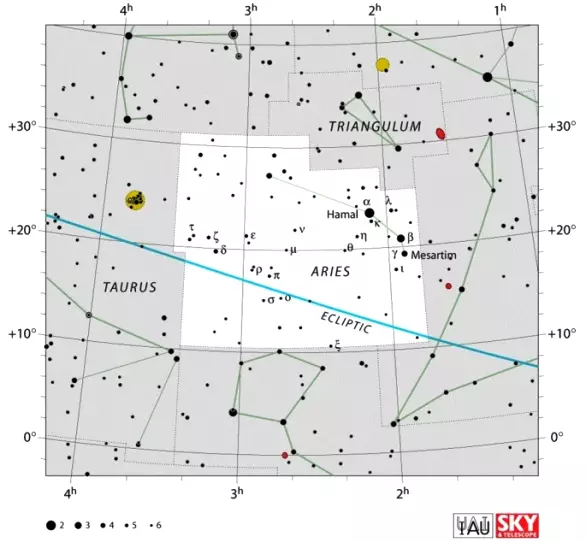
Aries constellation map by IAU and Sky&Telescope magazine (Roger Sinnott & Rick Fienberg) (CC BY 3.0)
Myth
The Babylonians identified Aries as an agrarian worker or a farmhand. In the Babylonian astronomical compendium MUL.APIN, the constellation was the last station on the ecliptic. It was called MULLÚ.ḪUN.GÁ (“the hired man” or “the agrarian worker”). The MUL.APIN was compiled in the 12th or 11th century BCE.
The name of the constellation changed to the Ram in late Babylonian times, but the reason for the change is uncertain. The reason may have been its association with the ancient Mesopotamian deity known as Dumuzid the Shepherd, the consort of the goddess Ishtar (or Inanna). The constellation came to be associated both with a hired hand and with Dumuzi’s ram. In early Bedouin lore, the Pleiades star cluster represented the Ram’s tail.
In the 7th century BC, the Neo-Babylonians did a revision of the Babylonian zodiac that placed Alpha Arietis, Hamal, very close to the vernal equinox. In Babylonian star catalogues, the vernal equinox was in Taurus.
In 130 BCE, the Greek astronomer Hipparchus defined the first point of Aries (the cusp of Aries) as the location of the March equinox. At the time, the equinox – the point at which the Sun crosses the celestial equator from north to south – was located in the western part of Aries, close to the border with Pisces. This was the point at which the Sun entered Aries, which is why it was named the first point of Aries.
Because of Earth’s axial precession (the slow wobble of Earth’s axis), the vernal equinox is no longer in Aries, but in the neighbouring Pisces. However, in 130 BCE, it was located just south of Gamma Arietis (Mesarthim) and was taken to be the starting point of the zodiac. Earth’s precession was traditionally known as the precession of the equinoxes.
In ancient Egypt, Aries was associated with the god Amon-Ra (Amun-Ra). The creator deity was depicted with a ram’s head and the constellation came to be called “Lord of the Head.” It was also known as the “Indicator of the Reborn Sun” because it contained the spring equinox.
In Greek mythology, Aries is associated with Chrysomallos, the golden ram that rescued Phrixus (or Phrixos), the son of the Boeotian king Athamas, and took him to Colchis, where Phrixus sacrificed the ram to Poseidon. The ram’s skin that he placed in a temple was the Golden Fleece, which later appears in the story of Jason and the Argonauts.
Phrixus and his sister Helle had a stepmother, Ino, who did not like them and wanted to get rid of them. She came up with a plan to put the land on the brink of famine by making sure the wheat crops failed. When a man was sent to consult the Oracle at Delphi, Ino bribed him to lie and say that the Oracle asked for the king’s children to be sacrificed so that the people would not starve.
Phrixus and Helle were saved by the winged ram with golden wool. The ram was sent by their real mother, the cloud nymph Nephele. It took both children and flew east to Colchis. Only Phrixus survived the journey. Helle fell off the ram and drowned in the Dardanelles. The strait was later renamed to Hellespont, or the sea of Helle, in her memory.
Phrixus was welcomed by King Aeëtes of Colchis, to whom he presented the Golden Fleece. In return, the king gave Phrixus his daughter Chalciope’s hand.
Aeëtes kept the Golden Fleece in a sacred grove, from where it was later stolen by Jason and the Argonauts, with the help of Medea, Aeëtes’ daughter. The fleece symbolized kingship and Jason needed it to be placed rightfully on the throne of Iolcus in Thessaly. King Pelias of Iolcus had sent him on the quest as a condition for ceding the throne.
Asterisms
The constellation Aries does not contain any particularly conspicuous asterisms. It hosts Musca Borealis, a star pattern formed by several relatively bright stars that used to form the constellation Musca Borealis.
Musca Borealis
Musca Borealis (the Northern Fly) is an asterism formed by Bharani (41 Arietis), 33 Arietis, 35 Arietis, and 39 Arietis (Lilii Borea). It is the remnant of the obsolete constellation Musca Borealis, once also known as Apes (“Bees”), Vespa (“Wasp”), and Lilium (the Lily). The asterism can be found using the brightest stars in Aries. A line drawn from Sheratan through Hamal points in its direction.
The name Lilium is remembered in the formal name of 39 Arietis, Lilii Borea (“in the north of Lilium”). The name Lilii Austrina (“in the south of Lilium”) once applied to 41 Arietis, now formally known as Bharani.
The southern counterpart to Musca Borealis, Musca Australis (the Southern Fly), is one of the modern 88 constellations. It is now known simply as Musca.
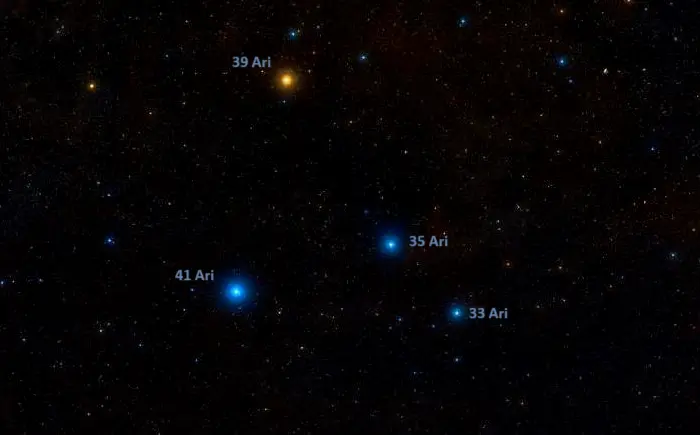
Musca Borealis (the Northern Fly), image: Wikisky (DSS2)
Major stars in Aries
Hamal and Sheratan, the brightest stars in Aries, are the only stars in Aries brighter than magnitude 3.0. They form a flat triangle with the fainter Mesarthim that makes the constellation recognizable. The three stars appear in the region between the elongated triangle of Triangulum (the Triangle) and the head of Cetus (the Sea Monster). They can be found using the Great Square of Pegasus and the bright stars of Andromeda.
Hamal – α Arietis (Alpha Arietis)
Hamal (α Ari) is the brightest star in the constellation Aries. It is on average the 50th brightest star in the sky. It is only slightly fainter than Polaris in Ursa Minor.
Alpha Arietis shines at magnitude 2.00 from a distance of 65.8 light-years. It is an evolved star on the red giant branch. It has the stellar classification K1IIIb, indicating an orange giant.
Hamal has a mass of 1.5 solar masses and a radius 15.19 times that of the Sun. With a temperature of 4,411 K, it is 76.2 times more luminous than the Sun. It spins at 3.44 km/s. The star is younger than the Sun, with an estimated age of about 3.4 billion years.
Alpha Arietis takes its name from the name of its host constellation. The name Hamal means “the ram” or “the lamb.” It comes from the Arabic phrase rās al-ħamal, meaning “head of the ram.”
Hamal is classified as a suspected variable star. Its brightness has been reported to vary between magnitude 1.98 and 2.04.
In 2011, astronomers reported the detection of a candidate planet in orbit around Hamal. The planet, Alpha Arietis b, has a mass of at least 1.8 Jupiter masses. It orbits the parent star with a period of 380.8 days at a distance of 1.2 astronomical units (AU).
Between 2000 and 100 BC, Hamal was located near the vernal equinox, the point that marks the beginning of spring. The date of the star’s conjunction with the Sun coincided with the spring equinox.
In modern times, the Sun conjuncts the star around April 24, more than a month after the vernal equinox. During this time, the constellation Aries is invisible in the night sky.
Sheratan – β Arietis (Beta Arietis)
Sheratan (β Ari) is the second brightest star in the Ram constellation. It has an apparent visual magnitude of 2.655 and lies 59.6 light-years away.
Sheratan is a white main sequence star of the spectral type A5 V. It has 2.067 times the Sun’s mass and a radius of 1.985 solar radii. With an effective temperature of 8,759 K, it shines with 20.9 solar luminosities. The star has an estimated age of 447 million years.
Sheratan is a rapid rotator. It has a projected rotational velocity of 73 km/s. It may be a mildly chemically peculiar Am star. These stars exhibit strong and sometimes variable absorption lines of metals. Observations with the Spitzer Space Telescope did not find any excess emissions in the infrared, which would indicate a circumstellar dust disk.
Sheratan is the primary component in a spectroscopic binary system with an orbital period of 106.9954 days. The companion, Beta Arietis B, appears at a separation of 36.1 milliarcseconds. It is four magnitudes fainter than Sheratan.
Beta Arietis B has a mass of 1.058 solar masses, indicating that it has a stellar classification in the range between F5 III-V and G0V. It has a radius of 1.12 solar radii and shines with 1.29 solar luminosities. The star has a surface temperature of 5,811 K.
The name Sheratan comes from the Arabic phrase aš-šarāţān, which means “the two signs.” The name is a reference to the vernal equinox, which the star marked together with Gamma Arietis (Mesarthim) a few thousand years ago.
Bharani – 41 Arietis (c Arietis)
Bharani (41 Ari) is a hot blue main sequence star of the spectral type B8 Vn. It has an apparent magnitude of 3.63 and lies 166 light-years away. It is the third brightest star in Aries.
Bharani has 3.1 times the Sun’s mass and is 160 times more luminous. It has a surface temperature of 11,900 K. The star is believed to be 130 million years old.
Bharani is an exceptionally fast spinner, with a projected rotational velocity of 175 km/s. Like all fast-spinning stars, it has an equatorial bulge and is flattened at the poles. The star’s equatorial radius is 12 percent larger than its polar radius.
Bharani was named after the second lunar mansion (division of the sky) in Hindu astrology. It was once known as Lilii Austrina (“in the south of Lilium”). The name was a reference to the obsolete constellation Lilium.
Mesarthim – γ Arietis (Gamma Arietis)
Mesarthim (γ Ari) is a binary or triple star system located around 164 light-years away in Aries. The system has a combined apparent magnitude of 3.86. It is the fourth brightest point of light in the constellation.
The two components are designated Gamma1 Arietis or Gamma Arietis B and Gamma2 Arietis or Gamma Arietis A. Gamma Arietis A (γ2 Arietis) is formally known as Mesarthim. The two stars are separated by 7.606 arcseconds. They orbit each other with a period of over 5,000 years.
Mesarthim is slightly brighter than its companion. It has an apparent magnitude of 4.58, while the companion shines at magnitude 4.64. The two stars are similar in mass and size. Gamma Arietis A has a mass of 2.72 solar masses and a radius 1.941 times that of the Sun. Component B has 2.67 times the Sun’s mass and a radius of 2.014 solar radii. Mesarthim is 41.5 times brighter than the Sun and the companion shines with 42 solar luminosities. The stars have an estimated age of only 34 million years.
Mesarthim is classified as an Alpha2 Canum Venaticorum variable. Its brightness varies by 0.04 magnitudes over a period of 2.61 days due to high chromospheric activity. Named after the class prototype Cor Caroli (Alpha Canum Venaticorum) in the constellation Canes Venatici, Alpha2 CVn stars are chemically peculiar stars with strong magnetic fields and strong lines of certain metals. They show brightness variations by 0.01 to 0.1 magnitudes with periods of 0.5 to 160 days.
Mesarthim is a subgiant star of the spectral type A2IVpSiSrCr. The suffix indicates strong lines of silicon, strontium, and chromium. The star may have a low-mass companion, a red dwarf.
Gamma Arietis B (γ1 Arietis) is a Lambda Boötis star, a chemically peculiar star with a very low abundance of iron peak elements in its spectrum. It is a main sequence star of the spectral type A0Vnp. It may form a spectroscopic binary star system with a companion with a mass of 0.7 solar masses.
Gamma Arietis is sometimes called the “First Star in Aries” because it was once the nearest visible star to the vernal equinox.
Botein – δ Arietis (Delta Arietis)
Botein (δ Ari) is a red clump giant of the spectral type K2 III. It has an apparent magnitude of 4.349 and lies around 170 light-years away.
The K-type star has a mass 1.91 times that of the Sun and a radius 10.42 times solar. It is 45 times more luminous than the Sun with a surface temperature of 4,810 K.
The brightness of Delta Arietis has been observed to vary from magnitude 4.33 to 4.37, and the star is classified as a suspected variable.
The name Botein is derived from the Arabic word Al Buṭayn or al butain, the diminutive of Al Baṭn, meaning “the belly.” It once applied to an asterism formed by Delta Arietis with Epsilon, Zeta, Pi and Rho3 Arietis.
Lilii Borea – 39 Arietis
Lilii Borea (39 Ari) is an evolved red clump giant star of the spectral type K1.5 III. It lies around 172 light-years away and shines at magnitude 4.514. It has a mass 1.6 times that of the Sun and has expanded to a size of 11.1 solar radii as it evolved away from the main sequence. It is now fusing helium in its core. With a surface temperature of 4,600 K, the giant star shines with 56 solar luminosities.
39 Arietis was named Lilii Borea by the French astronomer Nicolas-Louis de Lacaille in 1757. The name means “in the north of Lilium” and refers to the now-defunct constellation Lilium (the Lily). It was formally approved by the International Astronomical Union (IAU) in September 2017.
Teegarden’s Star (Gliese 10393)
Teegarden’s Star (GJ 10393) is a faint red dwarf located 12.497 light-years away. With an apparent magnitude of 15.13, the star is invisible to the unaided eye and can only be seen in large telescopes. It is much older than the Sun, with an estimated age of over 8 billion years. It hosts three known extrasolar planets, discovered in 2019 and 2024.
Teegarden’s Star is the 31st nearest star system to the Sun. It is one of the nearest stars that host potentially habitable planets, along with Proxima Centauri in the constellation Centaurus, Ross 128 in Virgo, and Tau Ceti in Cetus.
Gliese 10393 was discovered in 2003 and named after the astrophysicist Bonnard J. Teegarden, who led the team that discovered it. The star was discovered by examining asteroid-tracking data taken by the Near-Earth Asteroid Tracking (NEAT) program. The team did not directly use any telescopes.
Teegarden’s Star has a mass of 0.097 solar masses and a radius of 0.120 solar radii. With a rotational velocity of under 2 km/s, it takes around 99.6 days to complete a rotation.
Teegarden’s Star hosts three confirmed planets. The discovery of Teegarden’s Star b and Teegarden’s Star c was confirmed in 2019, and the third planet, Teegarden’s Star d, was discovered in 2024.
Teegarden b orbits in the habitable zone of its parent star (equivalent to the distance between Earth and Venus), and Teegarden c orbits on the outer edge of the habitable zone (comparable to the orbit of Mars). Both planets are slightly more massive than Earth. Teegarden b has an orbital period of only 4.91 days, and Teegarden c takes 11.416 days to complete an orbit.
Teegarden d has a mass at least 82% that of Earth and orbits beyond the habitable zone with a period of 26.13 days.
There may be other planets in the Teegarden’s Star system, but their existence has not been confirmed as of 2024.
SX Arietis (56 Arietis)
SX Arietis (56 Ari) is the prototype for a class of stars known as the SX Arietis variables. Its brightness varies from magnitude 5.75 to 5.81, with a baseline apparent magnitude of 5.79. The star lies approximately 415 light-years away. It has an estimated age of 174 million years.
SX Arietis variables are hot, fast-spinning B-type stars with strong magnetic fields and strong spectral lines of He I and Si III. Their brightness typically varies by 0.1 magnitudes with a period of about one day. The brightness variations are not intrinsic but caused by changes in the stars’ magnetic fields combined with the effect of rotation.
SX Arietis has 2.61 times the Sun’s mass and a radius 2.58 times the Sun’s. With a surface temperature of 12,420 K, it is 151 times more luminous than the Sun.
SX Arietis is a chemically peculiar star with the stellar classification B9pSi. It is a very fast spinner. With a rotational velocity of 160 km/s, it takes only 17.5 hours (0.7278972 days) to complete a rotation. The rotation period is increasing by 2 seconds every century.
HIP 14810
HIP 14810 is a yellow dwarf of the spectral type G6V. It lies 164.9 light-years away and has an apparent magnitude of 8.585. It appears 1.3 degrees north of Botein (Delta Arietis) and is too faint to be visible to the unaided eye.
The star has a mass 98% that of the Sun and a radius 108% that of the Sun. It shines with 99% of the Sun’s luminosity with an effective temperature of 5,535 K. It is a very slow spinner, with a projected rotational velocity of 0.54km/s.
The Sun-like star has an estimated age of 8.7 billion years. It hosts three confirmed exoplanets, HIP 14810 b, HIP 14810 c, and HIP 14810 d. The first two were discovered in 2006 and the third in 2009.
HIP 14810 b is a hot Jupiter with a mass of 3.88 Jupiter masses. It orbits the parent star at a distance of 0.0692 astronomical units and has an orbital period of 6.673892 days.
HIP 14810 c has a mass of at least 1.28 Jupiter masses. It orbits HIP 14810 at a distance of 0.549 AU in an eccentric orbit with a period of 147.747 days.
HIP 14810 d has at least 57% of Jupiter’s mass and orbits the host star at a distance of 1.89 AU. It has an eccentric orbit and an orbital period of 981.8 days.
The habitable zone of HIP 14810 lies between the two outer planets. Simulations suggest that a hypothetical Earth-like planet in the habitable zone could not have a stable orbit because of the orbits of these planets.
ε Arietis – Epsilon Arietis
Epsilon Arietis (ε Ari) is a visual double star located approximately 330 light-years away. The star system has a combined apparent magnitude of 4.63. It lies behind the dark cloud MBM12.
The two components are both A-type main sequence stars of the spectral type A2 Vs. The brighter star has an apparent magnitude of 5.2 and the companion shines at magnitude 5.5. The stars are separated by 1.426 ± 0.010 arcseconds and can be resolved in a telescope. Both components have a mass of 2.4 solar masses and spin at 60 km/s.
Deep sky objects in Aries
Aries does not contain any particularly bright deep sky objects. Most of the brighter objects in the constellation are galaxies. The constellation does not host any objects listed in the Messier and Caldwell catalogues. It contains a single object listed in the Herschel 400 catalogue, the spiral galaxy NGC 772.
Fiddlehead Galaxy – NGC 772
NGC 772 is an unbarred spiral galaxy in Aries. It is located about 130 million light-years from Earth and has an apparent magnitude of 11.1. It is larger than the Milky Way, with a diameter of about 200,000 light-years. The galaxy is catalogued as Arp 78 in the American astronomer Halton Arp’s Atlas of Peculiar Galaxies. It is sometimes called the Fiddlehead Galaxy.
With an apparent size of 7.2 by 4.3 across, NGC 772 can be spotted in amateur telescopes. It has several smaller companions. The smaller satellite galaxies include the elliptical galaxy NGC 770. The interaction with the neighbours is believed to have caused the emergence of an elongated outer spiral arm in NGC 772.
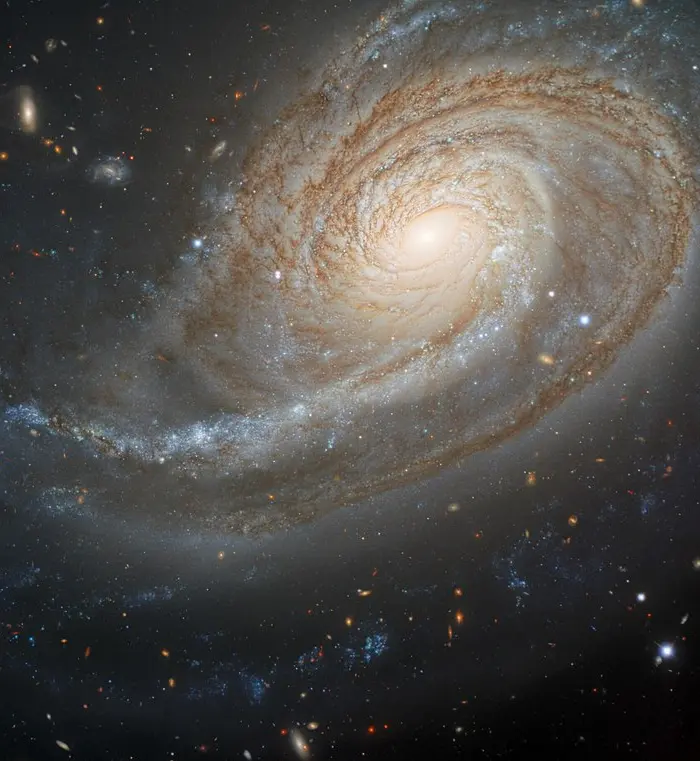
The overdeveloped spiral arm of the galaxy NGC 772, which was created by tidal interactions with an unruly neighbor, dominates this observation made by astronomers using the Gemini North telescope located near the summit of Maunakea in Hawai‘i. Credit: International Gemini Observatory/NOIRLab/NSF/AURA Image processing: T.A. Rector (University of Alaska Anchorage), J. Miller (Gemini Observatory/NSF’s NOIRLab), M. Zamani & D. de Martin (CC BY 4.0)
NGC 772 has hosted three supernovae in recent decades. In August 2003, the Type II supernova SN 2003hl peaked at magnitude 16.5. In October 2003, astronomers observed another Type II supernova in the galaxy, SN 2003iq, that shone at magnitude 16.4. In August 2022, the type IIP supernova SN 2022qze reached magnitude 19.9.
NGC 772 was discovered by the German-born British astronomer William Herschel on November 29, 1785. The galaxy appears southeast of Beta Arietis (Sheratan).
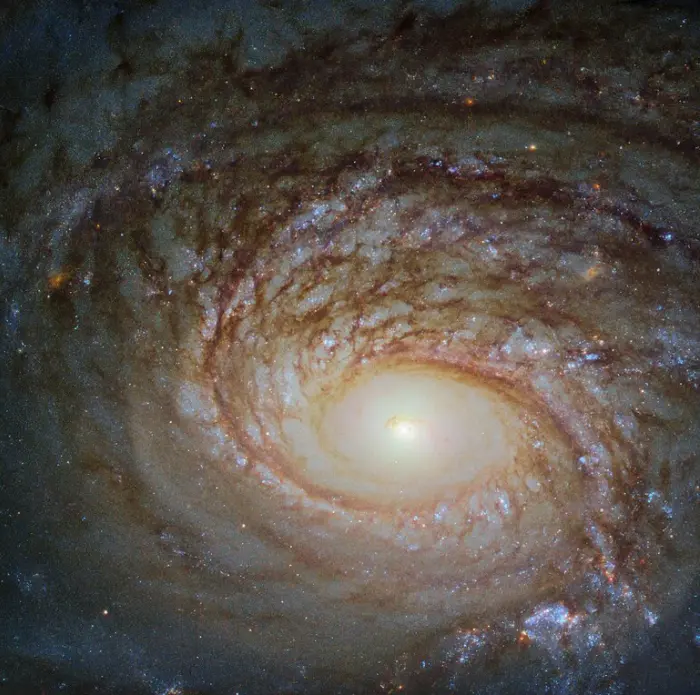
The Universe is simply so vast that it can be difficult to maintain a sense of scale. Many galaxies we see through telescopes such as the NASA/ESA Hubble Space Telescope, the source of this beautiful Picture of the Week, look relatively similar: spiralling arms, a glowing centre, and a mixture of bright specks of star formation and dark ripples of cosmic dust weaving throughout. This galaxy, a spiral galaxy named NGC 772, is no exception. It actually has much in common with our home galaxy, the Milky Way. Each boasts a few satellite galaxies, small galaxies that closely orbit and are gravitationally bound to their parent galaxies. One of NGC 772’s spiral arms has been distorted and disrupted by one of these satellites (NGC 770 — not visible in the image here), leaving it elongated and asymmetrical. However, the two are also different in a few key ways. For one, NGC 772 is both a peculiar and an unbarred spiral galaxy; respectively, this means that it is somewhat odd in size, shape, or composition, and that it lacks a central feature known as a bar, which we see in many galaxies throughout the cosmos — including the Milky Way. These bars are built of gas and stars, and are thought to funnel and transport material through the galactic core, possibly fueling and igniting various processes such as star formation. Image: ESA/Hubble & NASA, A. Seth et al. (CC BY 4.0)
NGC 770
NGC 770 is an elliptical galaxy located approximately 120 million light-years away. It appears just southwest of the larger NGC 772, to which it is gravitationally linked.
NGC 770 has a diameter of 36,000 light-years. It was discovered by R. J. Mitchell, assistant to William Parsons, 3rd Earl of Rosse, on November 3, 1855.
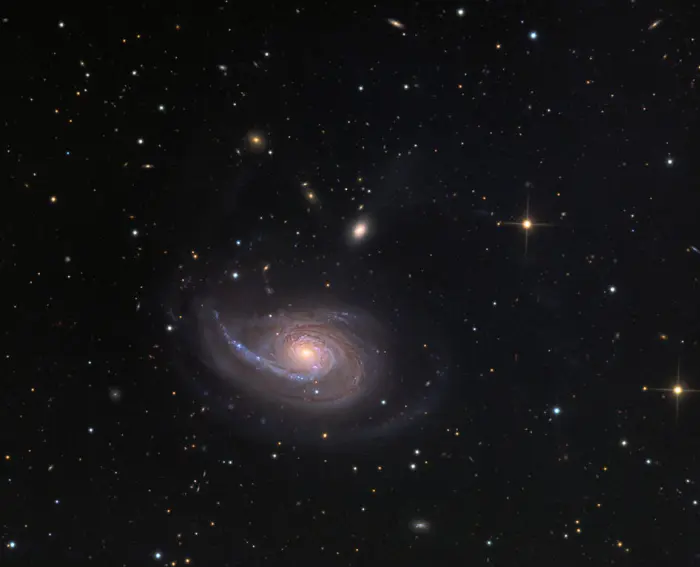
NGC 770 and NGC 772, image credit: Sid Leach/Adam Block/Mount Lemmon SkyCenter/University of Arizona (CC BY-SA 3.0 US)
NGC 821
NGC 821 is an elliptical galaxy located approximately 75.8 million light-years away. It has an apparent magnitude of 11.31. The galaxy is about 55,000 light-years across. It was discovered by William Herschel on September 4, 1786.
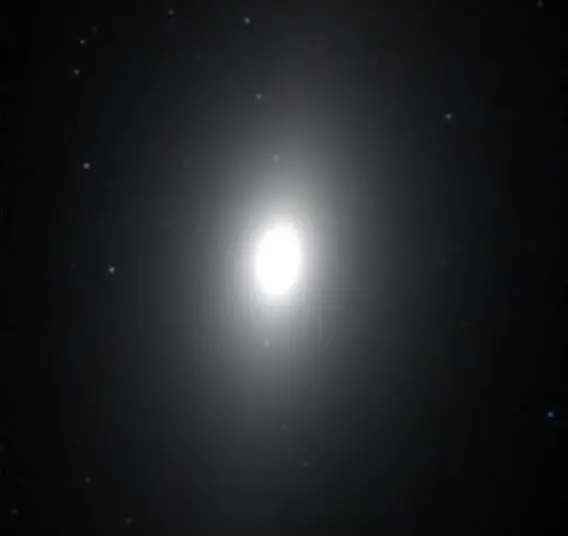
NGC 821, Hubble Space Telescope – Hubble Legacy Archive, based on observations made with the NASA/ESA Hubble Space Telescope, and obtained from the Hubble Legacy Archive, which is a collaboration between the Space Telescope Science Institute (STScI/NASA), the Space Telescope European Coordinating Facility (ST-ECF/ESA) and the Canadian Astronomy Data Centre (CADC/NRC/CSA) (PD)
NGC 1156
NGC 1156 is a dwarf irregular galaxy with an apparent magnitude of 12.3 and an apparent size of 3.3 by 2.5 arcminutes. The galaxy is classified as a Magellanic-type irregular galaxy. The galaxy’s core is larger than average and there are regions of contra-rotating gas inside it, believed to be the result of an interaction with another galaxy.
A candidate dark galaxy was discovered near NGC 1156 during the AGES survey in 2006. Detected with the Arecibo Radio Telescope, the galaxy contains a lot of hydrogen gas but not many bright stars. It is one of the few candidate dark galaxies – galaxies with few or no stars – discovered to date.
NGC 1156 lies northwest of Delta Arietis (Botein) and east of 41 Arietis (Bharani).
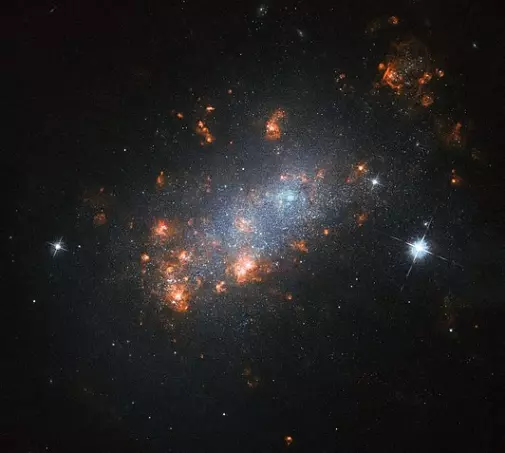
The galaxy NGC 1156 resembles a delicate cherry blossom tree flowering in springtime in this Hubble Picture of the Week. The many bright “blooms” within the galaxy are in fact stellar nurseries — regions where new stars are springing to life. Energetic light emitted by newborn stars in these regions streams outwards and encounters nearby pockets of hydrogen gas, causing it to glow with a characteristic pink hue. NGC 1156 is located in the constellation of Aries (The Ram). It is classified as a dwarf irregular galaxy, meaning that it lacks a clear spiral or rounded shape, as other galaxies have, and is on the smaller side, albeit with a relatively large central region that is more densely packed with stars. Some pockets of gas within NGC 1156 rotate in the opposite direction to the rest of the galaxy, suggesting that there has been a close encounter with another galaxy in NGC 1156’s past. The gravity of this other galaxy — and the turbulent chaos of such an interaction — could have scrambled the likely more orderly rotation of material within NGC 1156, producing the odd behaviour we see today. Image: ESA/Hubble, NASA, R. Jansen
NGC 972
NGC 972 is a spiral galaxy located approximately 49.8 million light years away. It has an apparent magnitude of 12.1. It is believed to have merged with a gas-rich galaxy, which resulted in asymmetrical arms and a burst of star formation in the galaxy’s core.
NGC 972 was discovered by William Herschel on September 11, 1784. It appears in the northern corner of the Aries constellation.
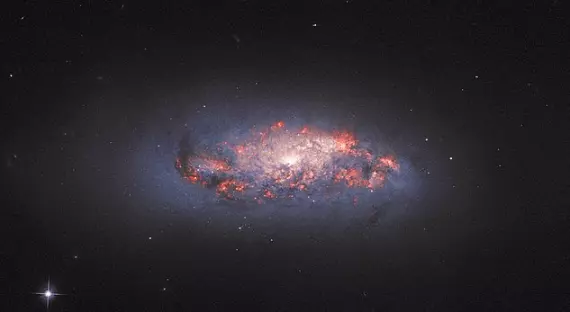
This NASA/ESA Hubble Space Telescope Picture of the Week shows bright, colourful pockets of star formation blooming like roses in a spiral galaxy named NGC 972. The orange-pink glow is created as hydrogen gas reacts to the intense light coming outwards from nearby newborn stars; these bright patches can be seen here amid dark, tangled lanes of cosmic dust. Astronomers look for these telltale signs of star formation when they study galaxies throughout the cosmos, as star formation rates, locations, and histories offer critical clues as to how these colossal collections of gas and dust have evolved over time. New generations of stars contribute to — and are also, in turn, influenced by — the broader forces and factors that mould galaxies throughout the Universe, such as gravity, radiation, matter, and dark matter. German-British astronomer William Herschel is credited with the discovery of NGC 972 in 1784. Astronomers have since measured its distance, finding it to be just under 70 million light-years. Image: ESA/Hubble, NASA, L. Ho (CC BY 4.0)
NGC 691
NGC 691 is an unbarred spiral galaxy located 119 million light-years away. It has an apparent magnitude of 11.5 and an apparent size of 3.5 by 2.6 arcminutes. The galaxy is about 130,000 light-years across. It was discovered by William Herschel on November 13, 1786.
NGC 691 hosted a supernova, observed in 2005. Designated SN 2005W, it peaked at magnitude 14.3 and was classified as a type Ia supernova.
NGC 691 is the most prominent member of the NGC 691 Group, which also includes the galaxies NGC 680, NGC 697, NGC 694, and IC 167.
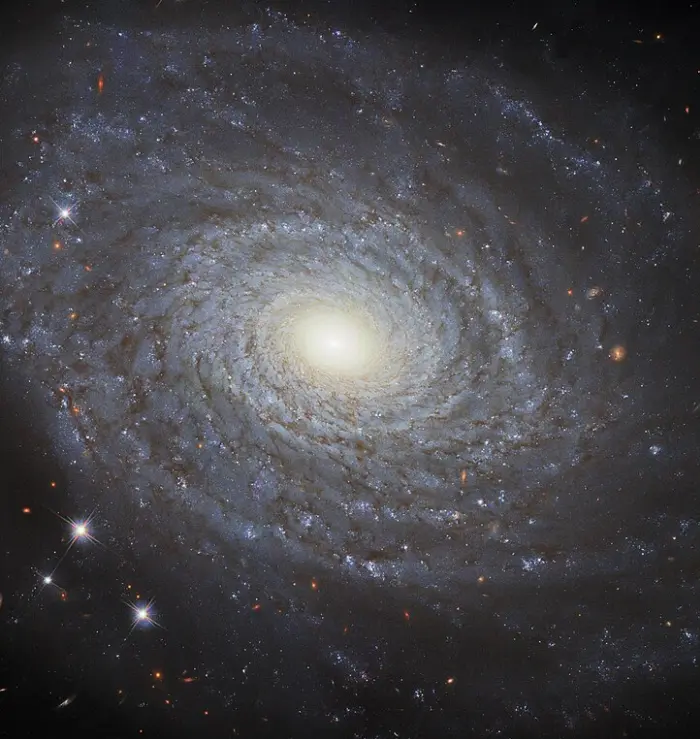
This image features the spiral galaxy NGC 691, imaged in fantastic detail by Hubble’s Wide Field Camera 3 (WFC3). This galaxy is the eponymous member of the NGC 691 galaxy group, a group of gravitationally bound galaxies that lie about 120 million light-years from Earth. Objects such as NGC 691 are observed by Hubble using a range of filters. Each filter only allows certain wavelengths of light to reach Hubble’s WFC3. The images collected using different filters are then coloured by specialised visual artists who can make informed choices about which colour best corresponds to which filter. By combining the coloured images from individual filters, a full-colour image of the astronomical object can be recreated. In this way, we can get remarkably good insight into the nature and appearance of these objects. Image credit: ESA/Hubble & NASA, A. Riess et al.; Acknowledgement: M. Zamani (CC BY 4.0)
IC 167
IC 167 is a barred spiral galaxy with an apparent magnitude of 14.0. It was discovered by the French astronomer Camille Guillaume Bigourdan in 1891.
The galaxy appears to share HI regions (clouds of neutral atomic hydrogen) with the nearby NGC 694, suggesting that the two galaxies may be interacting.
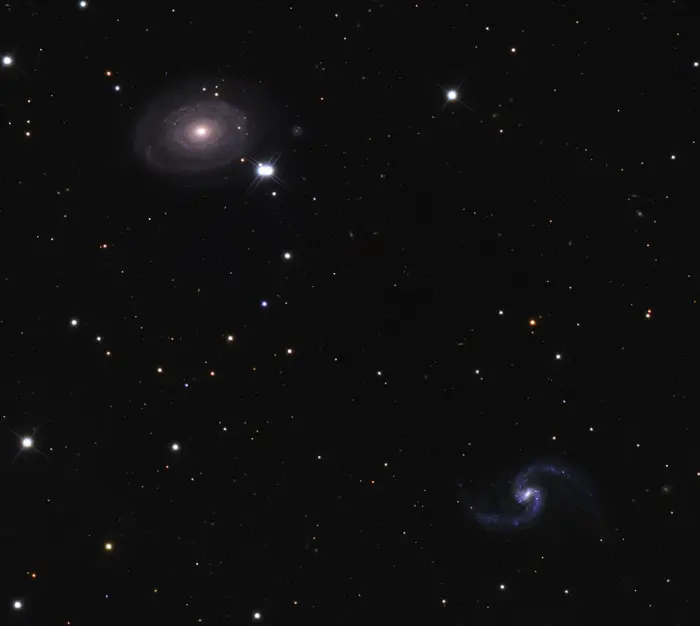
NGC 691 and IC 167, image credit: Adam Block/Mount Lemmon SkyCenter/University of Arizona (CC BY-SA 3.0 US)
NGC 694
NGC 694 is a spiral galaxy with an apparent visual magnitude of 13.30. It lies 136 million light years away and is a member of the NGC 691 Group. It appears 5.5 arcminutes north-northwest of IC 167.
The galaxy was discovered by the German astronomer Heinrich Louis d’Arrest on December 2, 1861. In 2014, it hosted a type II-P supernova, SN 2014bu, which shone at magnitude 15.5.
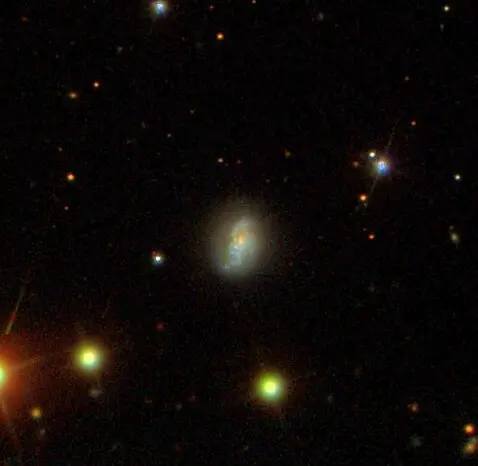
NGC 694, image: Sloan Digital Sky Survey (CC BY 4.0)
NGC 680
NGC 680 is an elliptical galaxy located around 123 million light-years away. It has an apparent magnitude of 11.9 and an apparent size of 1.9 by 1.6 arcminutes. It was discovered by William Herschel on September 15, 1784.
NGC 680 is a member of the NGC 691 Group. It is interacting with several other galaxies. As a result of the interaction, it has a disturbed, asymmetric shape, with two vast stellar plumes extending to the south-east and north-west. The galaxy was likely formed in a merger of two smaller galaxies 1-2 billion years ago.
NGC 680 forms a pair with NGC 678, which appears 5.5 arcminutes to the northwest. Another galaxy, IC 1730, appears in the same field of view.
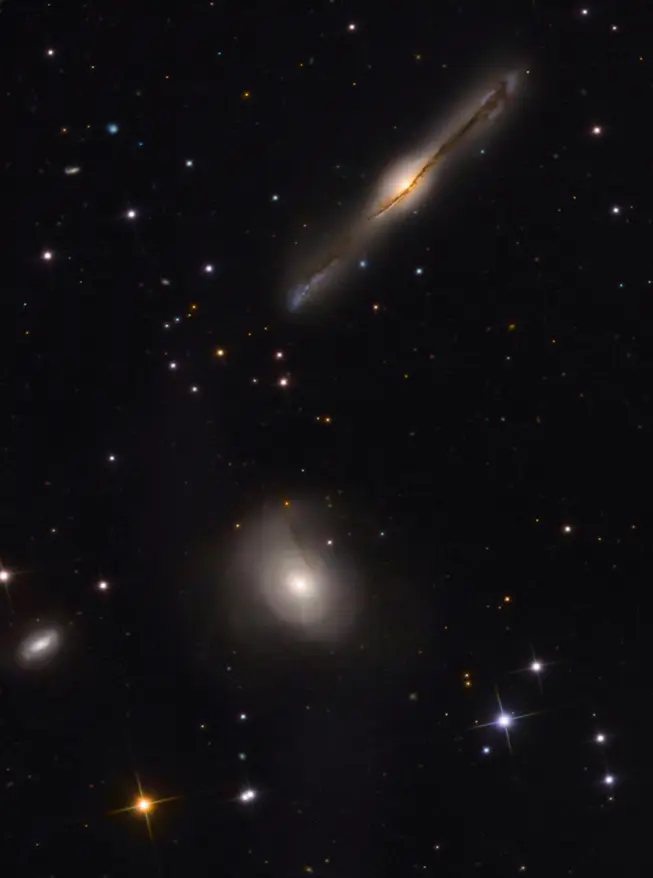
NGC 678 (top), NGC 680 (centre) and IC 1730 (left), image credit: Adam Block/Mount Lemmon SkyCenter/University of Arizona (CC BY-SA 3.0 US)
NGC 695
NGC 695 is a disturbed spiral galaxy with an apparent magnitude of 12.80. It lies 450 million light-years away and has an apparent size of only 30 by 24 arcseconds.
The galaxy was discovered by William Herschel on November 13, 1786. It has a highly luminous starburst disk and its spiral arms are loosely wound because it is interacting with a small companion. Astronomers have detected extended radio emission from NGC 695, which may indicate the presence of an active supermassive black hole.
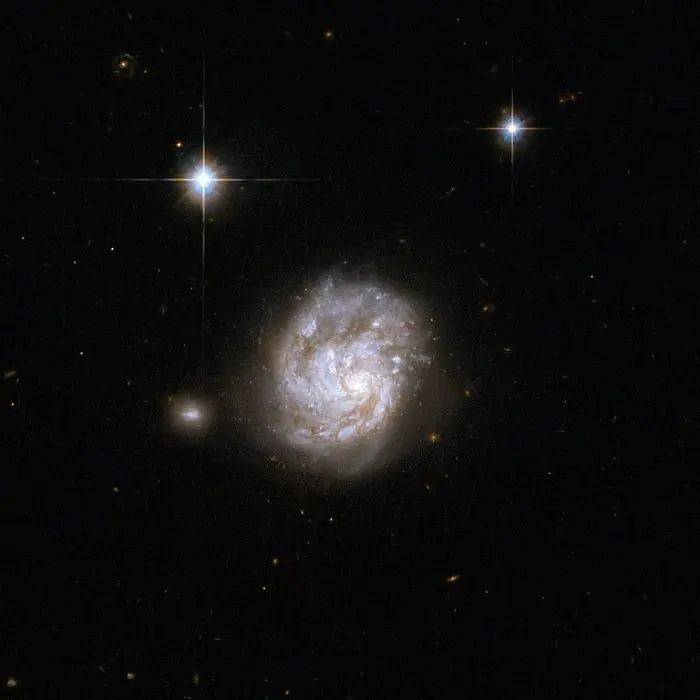
NGC 695 is a peculiar galaxy which looks like a revolving tornado. It is a disturbed spiral galaxy, seen face-on, with loosely wound spiral arms. Knotty star-forming regions are tangled in a mesh of dust and gas. NGC 695 is in an interaction with a small companion located just outside the image to the left. Scientists believe that this is a recent but relatively weak interaction. NGC 695 is located in the constellation of Aries, the Ram, about 450 million light-years away from Earth. Credit: NASA, ESA, the Hubble Heritage (STScI/AURA)-ESA/Hubble Collaboration, and A. Evans (University of Virginia, Charlottesville/NRAO/Stony Brook University) (PD)
NGC 674 (NGC 697)
NGC 674 is a spiral galaxy located 105 million light-years away. It has an apparent magnitude of 12.7. It appears northwest of Beta Arietis (Sheratan).
The galaxy was discovered by William Herschel on September 15, 1784. It was originally listed as NGC 697 and later found to be a duplicate of NGC 674.
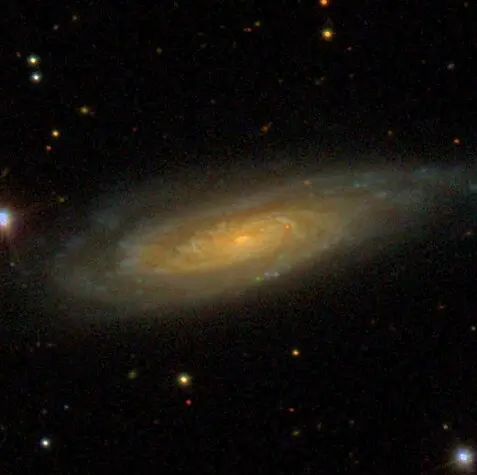
NGC 697 (NGC 674), credit: Sloan Digital Sky Survey (CC BY 4.0)
NGC 918
NGC 918 is a barred spiral galaxy located approximately 67 light years away. It is classified as an active nucleus galaxy (AGN). It has an apparent visual magnitude of 15.01.
NGC 918 is a field galaxy. It does not appear to belong to any galaxy cluster or group. The galaxy has hosted two observed supernovae. The Type II supernova SN 2009js was detected in October 2009, and the Type Ia supernova SN 2011ek was discovered in August 2011.
NGC 918 was discovered by the English astronomer John Herschel (son of William Herschel) on January 11, 1831.
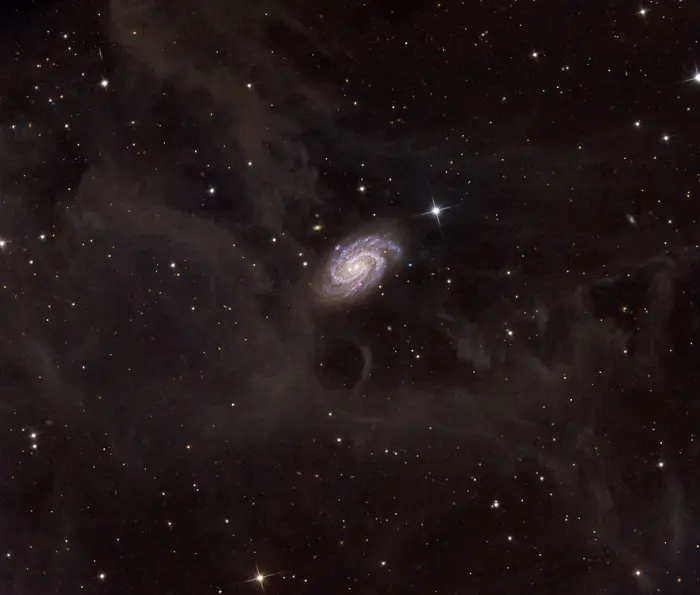
NGC 918, image credit: Adam Block/Mount Lemmon SkyCenter/University of Arizona (CC BY-SA 3.0 US)
Arp 276 – NGC 935 and IC 1801
NGC 935 and IC 1801 are an interacting pair of galaxies located 189 million light-years away. They have apparent magnitudes of 12.5 and 14.56. NGC 935 appears slightly larger, with an apparent size of 1.857 by 1.077 arcminutes, while NGC 1801 appears 1.517 by 0.849 arcminutes across.
NGC 935 hosted a Type Ib supernova, designated SN 2006F, in 2006. The supernova had an apparent magnitude of 17.3. A supernova of unknown type, SN 1976H, was detected in IC 1801 in 1976. It shone at magnitude 15.
The merging duo is listed as Arp 276 in Halton Arp’s Atlas of Peculiar Galaxies.
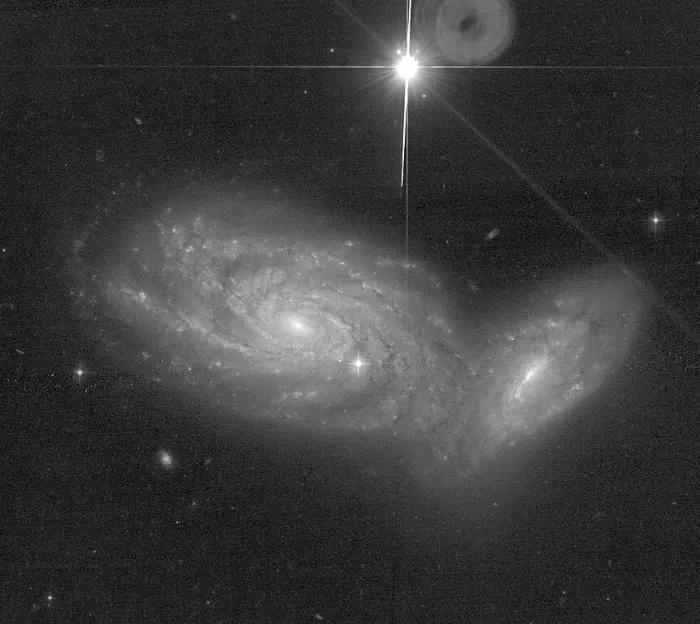
Arp 276 (NGC 935, IC 1801) with the Hubble Space Telescope, image: NASA/ESA Hubble (CC BY-SA 4.0)
UGC 2369
UGC 2369 is a pair of interacting spiral galaxies in Aries. The galaxies lie 424 million light-years away. They are connected by a prominent bridge of stars, dust and gas. The bridge consists of material pulled from the galaxies as a result of their close encounter. The galaxies will eventually merge into a single larger galaxy.
The two galaxies, UGC 2369N and UGC 2369S, are similar in size. Both appear distorted because mutual tidal forces are pulling them closer together. The galaxies were captured by the Hubble Space Telescope in 2019.
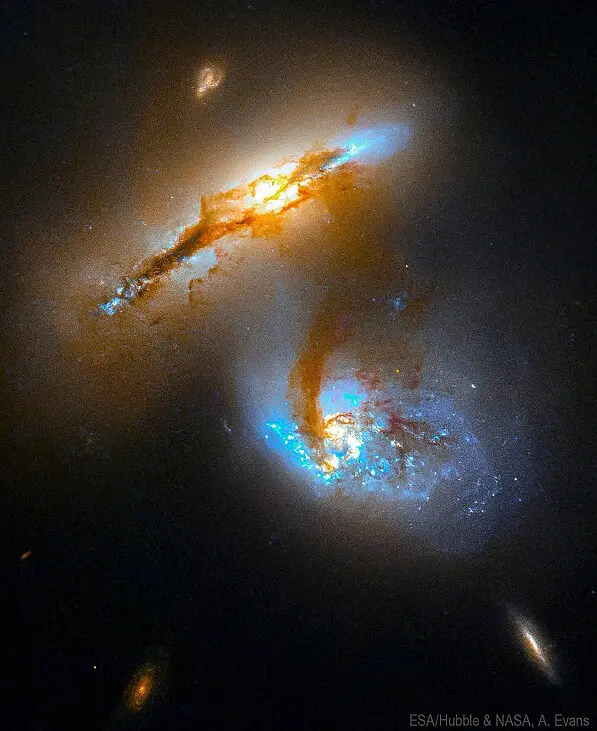
The pair of strange, luminescent creatures at play in this image are actually galaxies — realms of millions upon millions of stars. This galactic duo is known as UGC 2369. The galaxies are interacting, meaning that their mutual gravitational attraction is pulling them closer and closer together and distorting their shapes in the process. A tenuous bridge of gas, dust and stars can be seen connecting the two galaxies, created when they pulled material out into space across the diminishing divide between them. Interaction with others is a common event in the history of most galaxies. For larger galaxies like the Milky Way, the majority of these interactions involve significantly smaller so-called dwarf galaxies. But every few billion years, a more momentous event can occur. For our home galaxy, the next big event will take place in about four billion years, when it will collide with its bigger neighbor, the Andromeda galaxy. Over time, the two galaxies will likely merge into one — already nicknamed Milkomeda. Image credit: ESA/Hubble & NASA, A. Evans (CC BY 2.0)
NGC 877
NGC 877 is an intermediate spiral galaxy with an apparent magnitude of 11.8. It lies approximately 154 million light-years away and has an apparent size of 2.4 by 1.8 arcminutes. The galaxy has a physical diameter of about 115,000 light-years. It was discovered by William Herschel on October 14, 1784.
NGC 877 is a disturbed grand design spiral galaxy with prominent spiral arms. It has a high rate of star formation and is classified as a luminous infrared galaxy (LIRG), a galaxy with a luminosity over 100 billion times that of the Sun. LIRGs produce many more stars than the Milky Way, which contributes to their high luminosity. NGC 877 is estimated to spawn 20 – 53 solar masses per year. In comparison, the Milky Way produces about one star per year.
NGC 877 is interacting with the edge-on spiral galaxy NGC 876, a fainter neighbour located 2.1 arcminutes to the southwest. The galaxies are separated by about 30 kiloparsecs and connected by a faint bridge of gas.
NGC 877 is the most prominent member of the NGC 877 Group (LGG 53), which also includes NGC 876, NGC 871, IC 1791, and several other galaxies.
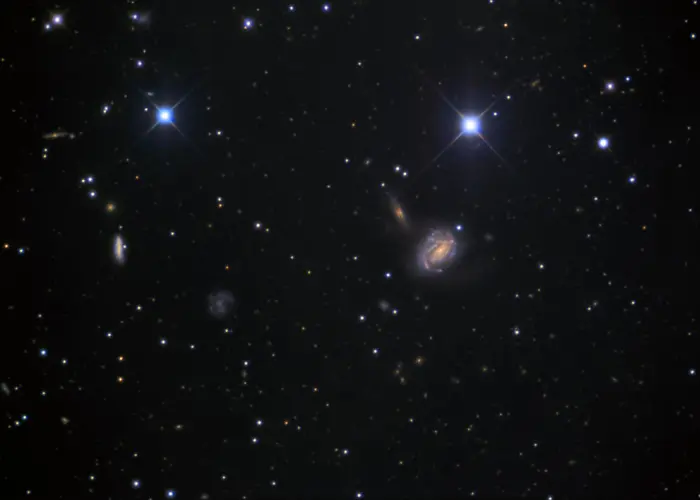
NGC 876 (the edge-on galaxy) and NGC 877 are not nearby. As measured by the recessional velocity due to the expansion of the Universe, these galaxies are more than 150 million light years away. Since both galaxies on the right display the same redshift, it is reasonable to think that they are interacting with one another. Certainly the long sweeping arms of NGC 877 hints at this gravitational influence. Based on their projected angular separation these two galaxies are separated by between 150,000 to 200,000 light years. This is roughly the same as the distance from the Milky Way to the Magellanic clouds. Image credit: Adam Block (CC BY-SA 3.0 US)
NGC 719
NGC 719 is a lenticular galaxy located approximately 400.4 million light years away. It has an apparent visual magnitude of 14.83. It was discovered by the German astronomer Heinrich Louis d’Arrest on November 24, 1861.
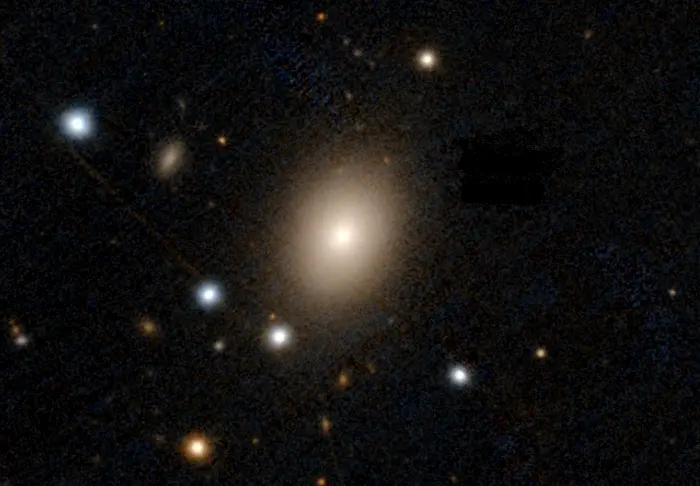
NGC 719, Image created using the Aladin Sky Atlas software from the Strasbourg Astronomical Data Center and
Pan-STARRS (Panoramic Survey Telescope And Rapid Response System), credit: Donald Pelletier (CC BY-SA 4.0)
PSO J0309+27
PSO J0309+27 (short for PSO J030947.49+271757.31) is a blazar with a comoving distance of 27.6 billion light-years. It was discovered in 2000. At the time of discovery, it was the most distant blazar known, with a redshift of 6.1. The light from the object took about 12.7 billion years to reach Earth. It was produced when the universe was less than 1 billion years old.
A blazar is an active galactic nucleus (AGN) with a relativistic jet believed to be powered by material being pulled into a supermassive black hole at the centre of a galaxy. As the dust and gas fall into the black hole, a hot accretion disk forms that produces vast amounts of energy, fuelling emission across the spectrum.
The relativistic jet is composed of ionized gas and dust moving at nearly the speed of light. If a jet is pointed towards Earth, the blazar appears much brighter due to the beaming of electromagnetic radiation from the jet.